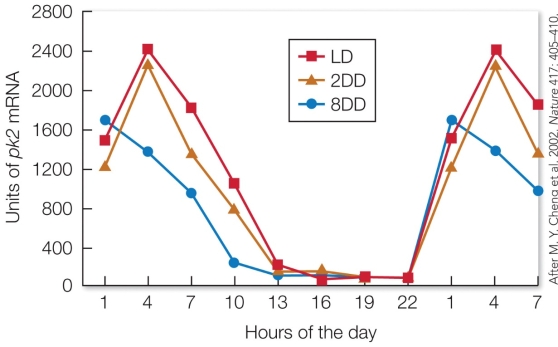Refer to the figure. This figure shows the hourly changes in the production of messenger RNA (mRNA) encoded by the PK2 gene in mice exposed to a light-dark cycles of 12 hours of light and 12 hours of darkness (LD) , complete darkness for 2 days (2DD) , and complete darkness for 8 days (8DD) . How do these results support the hypothesis that PK2 is a clock messenger?
This figure shows the hourly changes in the production of messenger RNA (mRNA) encoded by the PK2 gene in mice exposed to a light-dark cycles of 12 hours of light and 12 hours of darkness (LD) , complete darkness for 2 days (2DD) , and complete darkness for 8 days (8DD) . How do these results support the hypothesis that PK2 is a clock messenger?
A) The production of PK2 depends on the amount of daylight that is available.
B) PK2 is produced in a circadian pattern independent of light-dark cues.
C) A mutation in certain key clock genes disrupts the circadian rhythm of PK2 production.
D) Prolonged periods of darkness increase the expression of the gene that produces PK2.
Correct Answer:
Verified
Q3: Refer to the figure. Q4: Refer to the figure. Q5: Refer to the figure![]()
![]()
![]()

